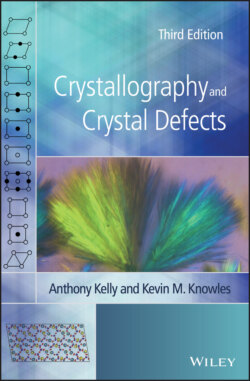Читать книгу Crystallography and Crystal Defects - Anthony Kelly - Страница 55
Notes
Оглавление1 1 It is also possible to use rotoreflection axes [1], pp. 23–30, also termed alternating axes [2], p. 117, in developing the point groups. These repeat an object by rotation coupled with reflection in a plane normal to the axis. Onefold, twofold, threefold, fourfold, and sixfold rotoreflection axes are possible, usually denoted (pronounced ‘one tilde’), , , and respectively. is clearly equivalent to a mirror plane.
2 2 Our symbols are identical to those used in the International Tables for Crystallography [3], with the exception of ‘’, which in the International Tables is always indicated by the symbol for a mirror plane.
3 3 All the individual faces of the form {hkl} are crystallographically identical. In a similar way, if a single direction is given, say [uvw], then all the directions produced if the repetition operations of the point group are carried out on the initial direction are called the family of directions of the type uvw and are given the symbol 〈uvw〉.
4 4 These are termed Miller−Bravais indices (or Bravais−Miller indices, the form used in [3]), because Auguste Bravais (1811−1863) was the first to show the relationship expressed in Eq. (2.2) in Equation (13) on page 119 of his Études Cristallographiques [6], published posthumously in 1866, but first presented to the French Academy of Sciences on 26 February 1849.
5 5 There is no ‘perfect’ choice of nomenclature for this redundant third axis. The choice of u in the term u‐axis here should not be confused with the u in the nomenclature [uvw] introduced in Section 1.2 for vectors and is in deference to Georges Friedel who chose this nomenclature when describing Miller−Bravais indices for planes in hexagonal and trigonal materials [7]. Friedel chose a nomenclature for planes and vectors which did not use the {hkl} and 〈uvw〉 notations in familiar use today [3].
6 6 The symbol || means ‘parallel to’.
7 7 The relationship between the two cells used in Figures 2.16 and 2.17 is shown in Figure A4.2a, where general methods of transforming the indices of planes and directions, when different unit cells are chosen for the same crystal, are considered.
8 8 The 230 space groups were established in the late 1880s and early 1890s through the work of Evgraf Stepanovich Fedorov (1853−1919) and Arthur Moritz Schoenflies (1853−1928). An account of how these two scientists arrived at the definitive set of space groups is given in [9], available as a free online version at https://www.iucr.org/publ/50yearsofxraydiffraction.
